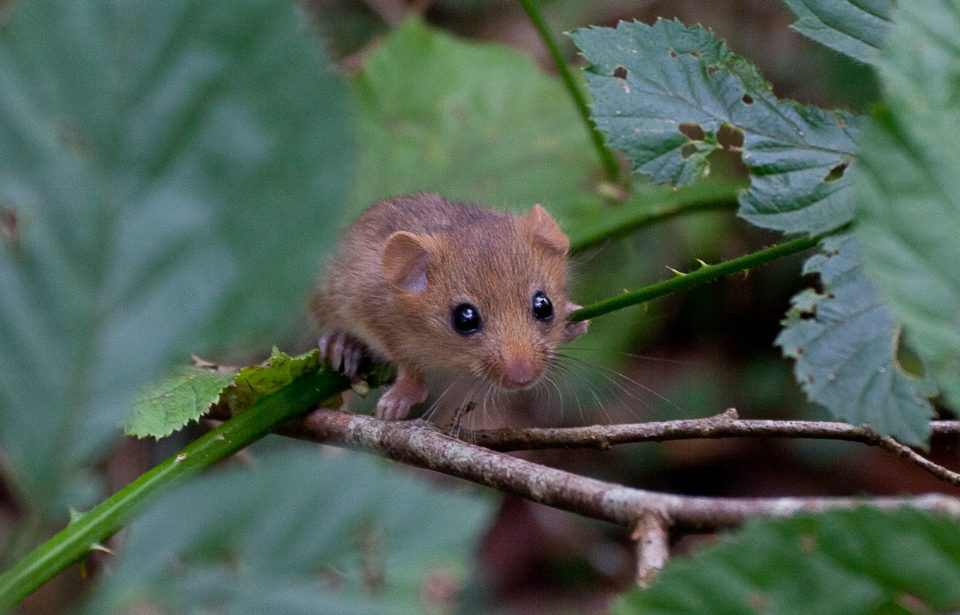June 2021 marked an important event for the People’s Trust for Endangered Species (PTES): the 1,000th captive-bred hazel dormouse was released into the wild under their reintroduction scheme. This incredibly successful campaign has been helped to this milestone in part by an unlikely group of people: the inmates of HMP Doncaster and HMP Humber.
The hazel dormouse
The hazel dormouse is more commonly referred to simply as “the dormouse” in Britain because it is the only dormouse species native to the British Isles rather than introduced. In 2010, a hazel dormouse was discovered in County Kildare, and these adorable creatures seem to be thriving in Ireland thanks to an abundance of hedgerows.
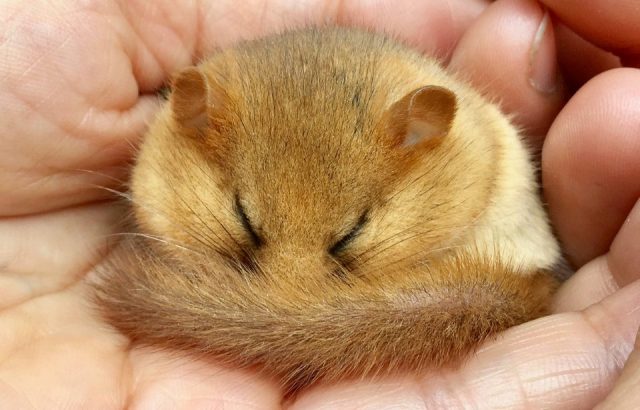
The body of a hazel dormouse measures about 10 centimeters (3.9 inches) long, while the fur-covered tail can add another 5.7–7.5 centimeters (2.2–3.0 inches) to the overall length. It has black eyes, small ears, and its fur is mainly reddish-brown turning to golden-brown on its stomach. During the summer months, it weighs 17–20g (0.60–0.71 oz), but its body weight can virtually double just before it goes into hibernation.
Hazel dormice generally live in and around trees and are incredibly wary of crossing open ground. Their preferred diet includes berries, nuts, fruit, aphids, and caterpillars, but when a dormouse needs to fatten up for hibernation, it mostly eats hazelnuts.
Hazelnuts displaying a neat, round hole in the shell are a sign that dormice are in the vicinity. Dormice, wood mice, and bank voles eat hazelnuts in this distinctive way, unlike squirrels and birds which will split the shell or make a more jagged hole.
As well as hibernating from October to April or May, the dormouse might also spend some time in a torpor during the summer months if the weather is particularly cold and wet or if there is a scarcity of food. The fact that a dormouse spends a lot of its life asleep accounts for the many pictures of curled-up, sleeping dormice, and also the creature’s famous portrayal in Alice in Wonderland.
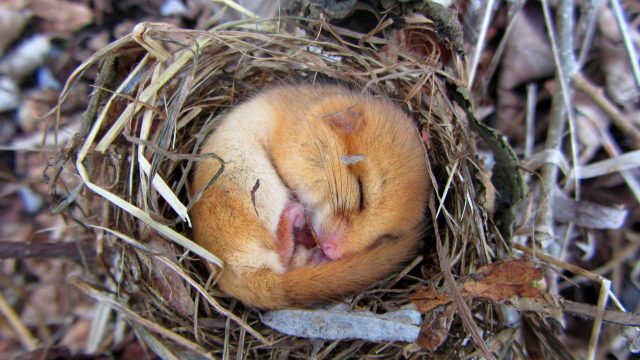
Sadly, the loss of woodland habitats as well as a warming climate are proving to be a significant threat to hazel dormice. A 2020 study found that their numbers have declined by 51% in the last 20 years, and they are actually extinct in 17 English counties.
Reintroduction scheme
As part of their Back on our Map (BOOM) reintroduction scheme, PTES has carried out annual dormice reintroductions since 1993. BOOM is a joint effort between PTES, the University of Cumbria, and the Morecambe Bay Partnership to reinstate 10 locally extinct or threatened species across Britain.
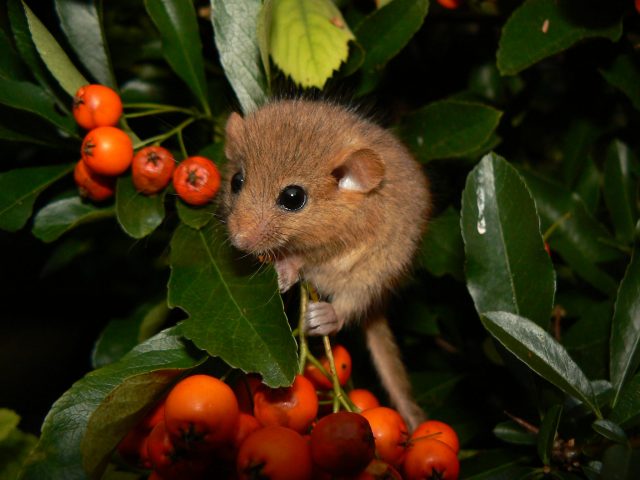
However, the success of a reintroduction scheme depends on a suitable habitat in which the animals can live. As such, PTES has chosen areas with correct woodland management practices. In a PTES press release, Jim Turner, Reserve Manager for Natural England, said: “We know hazel dormice thrive in well-managed woodlands, which is why we chose an area with a range of tree species and ages — from mature oaks to newly coppiced hazel — which will give the dormice plenty of food and opportunities to nest. The Arnside and Silverdale AONB is rightly proud of their fantastic woodlands, which have been cared for over many years by local landowners, conservation organizations, volunteers, and woodland businesses.”
In June 2021, 15 breeding pairs or trios of dormice were released into an undisclosed location in the Arnside and Silverdale Area of Outstanding Natural Beauty in north Lancashire and south Cumbria. Before being released, each dormouse undergoes a nine-week quarantine period, during which time vets from the Zoological Society of London conduct regular health checks.
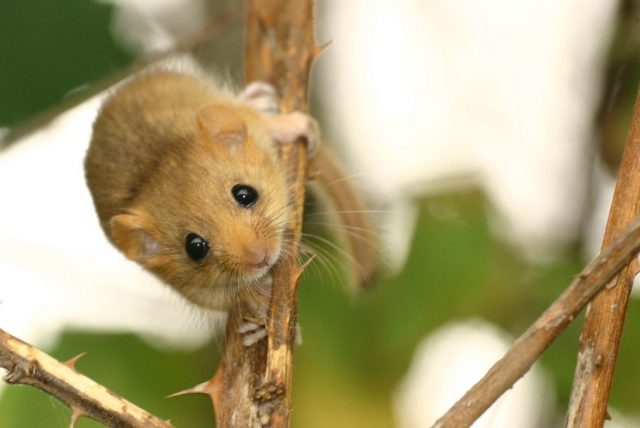
Once they’re given a clean bill of health, the dormice are transported to their new home. Dr. Deborah Brady is a Research Fellow at the University of Cumbria managing the reintroduction for BOOM. She explains: “Once the dormice arrive they are placed into mesh cages that mirror the woodland. The cages are filled with the right mix of foliage, buds, berries, nuts, insects, and water, and this is where the dormice will live for the first 10 days.
“Each cage is connected to a tree, so the dormice become acclimatized to their new surroundings. Our local volunteers will check each cage daily and will also act as monitors over the next two years to ensure all the dormice remain healthy.”
Jo Sayers, BOOM Project Manager at the University of Cumbria, is optimistic about the program: “This is the first of two hazel dormouse releases planned for the Arnside and Silverdale woodlands, and we hope by next summer there will be around 80 dormice living in our woodlands.”
The assistance of prisoners
Dormice might be small, but the reintroduction project is huge. It is only possible due to months of dedication from many organizations and funding from The National Lottery Heritage Fund. The Common Dormouse Captive Breeders Group (CDCBG), Wildwood Trust (a key member of the CDCBG), and ZSL (Zoological Society of London) have all played vital roles in the reintroduction program.
More unusually, the PTES has also joined forces with prisons in Doncaster and Humber to provide these tiny creatures with a new home. While dormice usually make their nests of woven honeysuckle bark, fresh leaves, and grass, they will also live in PTES’s specially-made nest boxes that resemble bird boxes.
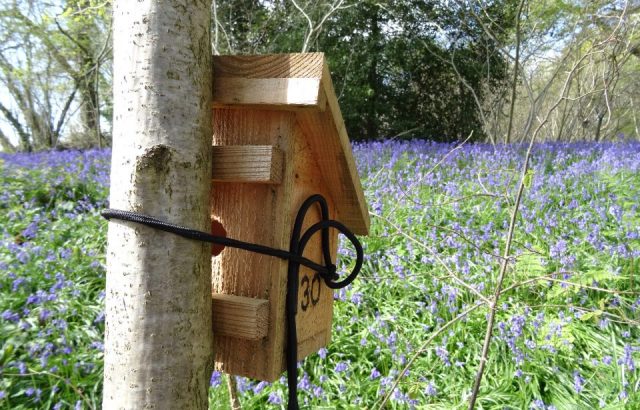
Not only do they provide alternative nesting places for the dormice when resources are scarce, but these boxes allow members of the National Dormouse Monitoring Programme (NDMP) to collect data from nest boxes around the country.
HMP Doncaster and HMP Humber have been participating in this scheme since 2010. As of May 2016, inmates had created 10,983 nest boxes which were installed at nearly 150 of the 400 NDMP sites around the country.
In a press release from 2016, Ian White, Dormouse & Training Officer at PTES, said: “We are delighted to have reached the milestone of 10,000 dormouse nest boxes. Hazel dormice have declined significantly over the last century, so they need all the help they can get. Our collaboration with the Prison Service is an invaluable part of our national effort to conserve this endangered species and their contribution is making a real difference.”
More from us: Dire Wolves: The Ancient Canids That Inspired ‘Game Of Thrones’
Carrying out such voluntary work means that prisoners are gaining new, practical teamwork skills. They also received an award from the National Offender Management Service Wildlife Awards for this community work.
Ian Telfer, Governor of HMP Humber, said: “We approached PTES about this partnership as we wanted to allow our men the opportunity to give something back, as well as helping to save the hazel dormouse from extinction. To be recognized for the Judges Gold Commendation Award is an achievement we are all very proud of.”
